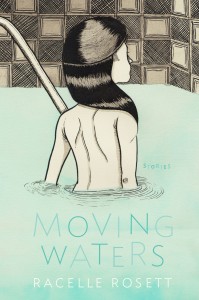The Lilith Blog 1 of 2
February 7, 2013 by Yona Zeldis McDonough
A Conversation with Racelle Rosett
 Your stories all center on a group of Reform Jewish community in Hollywood; is this a community you know well from personal experience?
Your stories all center on a group of Reform Jewish community in Hollywood; is this a community you know well from personal experience?
The temple my kids grew up in is nicknamed “Temple Beth Showrunner” because the creators of so many television shows attend. But when you sit in the sanctuary year after year you see that loss is loss. That’s what interested me – that in LA where are lives are so disparate, the temple remained a destination of healing and connection.
There is a moment as an adult when you suddenly deeply understand Shehechianu. When you realize how extraordinary a blessing it is to arrive, sustained at this moment. You are keenly aware of the loved ones who did not arrive with you. You make this journey with your community – it would be unbearable without it.
Jewishly, Los Angeles has an incredibly dynamic scene right now there seems to be a real desire to connect and also a vigorous mission of social action. Sharon Brous an LA rabbi was named one of the most influential rabbis in the country. East Side Jews is an organization that creates gleefully irreverent but deeply spiritual gathering for young Jewish people outside of temple. It’s exciting to see how our Jewish lives inform our daily lives – how relevant and useful these rituals are – even now, even in LA.
Do you feel there is a distinct difference between Jews in say, Los Angeles, and Jews in New York City?
Well, I had Zabar’s flown in for my son’s briss. In LA on Simchat Torah they serve sushi to commemorate the scroll. But lox is lox! I think we are less different than we are the same. We are the same in the ways that most matter. Allegra Goodman’s collection Total Immersion is set in Hawaii, but I think that is the same delight of stepping into a temple in a different country or a different community. If you wait a few moments the Shma will be said and you’ll know who you are.
Has your work as a television writer had an impact on your fiction?
It certainly has in the way that I envision the scenes; they unfold for me in a very visual way. But the great pleasure of fiction in this case is the intimacy of the storytelling. I am able to spend a time with my characters in a very interior world.
Are the stories in this collection an attempt to reconcile the spiritual with the secular?
What I think it mysterious and beautiful is that these things cannot be reconciled and yet reside together in our lives. Much of what we pursue when it comes to faith does not make sense but makes it possible to live in a secular world. There is a sigh that takes over your body when you enter a sanctuary. For me it is the value and respect for the spiritual that makes the rest possible. I think this is true in the story New Jew. When you hold an infant and feel the weight of its fragility – you pray. It matters very little what you believe or what you think know– the prayer is what you enact in that moment.
What are you working on now?
In the 70’s I lived in the Sde Boker in a youth village of students from all over the world that was part of Ben Gurion’s effort to “make the desert bloom. I am working on a coming of age novel about these young students living in the Negev and follows the same group of characters as adults, and traces their changing relationship to Israel. The title Mizrach/East is taken from the traditional papercuts that were displayed on the Eastern walls of the homes of Jews living outside of Israel, so that they could turn in the direction of Jerusalem to pray.
Learn more at www.racellerosett.com.
 Please wait...
Please wait...
Pingback: ATW Talking PointsFeb. 11, 2013 | Hollywood Journal – Soul of the Biz